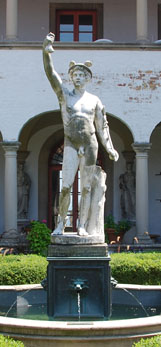Hermes was purchased from Italy over a hundred years ago by a private New York collector. The statue was then on loan to Williams College in Williamstown, Massachusetts from the 1920s until its sale in the 1960s. The Milwaukee Art Center Garden Club purchased the statue in 1967 for $10,000 and commissioned a local sculptor, Dick Wilken, to create the decorative bronze pedestal for Hermes. The pedestal is designed with four lion heads and water jets with a pool surrounding the statue.
Acquisition
The Villa Terrace Decorative Arts Museum was originally named Sopra Mare, the Italian Renaissance villa style home was built in 1922 for the family of Lloyd Raymond Smith by Chicago architect David Adler. This home was private until 1966 when Milwaukee County received the villa as a gift of Mrs. John Jacob Curtis, Lloyd Smith's surviving spouse. The following year the facility opened the building to the public as a Decorative Arts Museum. In order to enhance the museum The Garden Club renovated the courtyard. [1] [2]
This page is based on this
Wikipedia article Text is available under the
CC BY-SA 4.0 license; additional terms may apply.
Images, videos and audio are available under their respective licenses.

